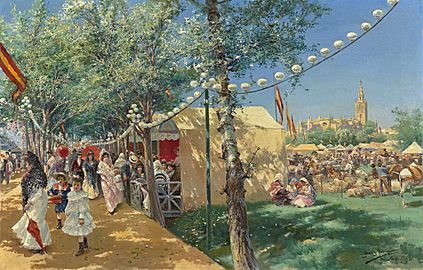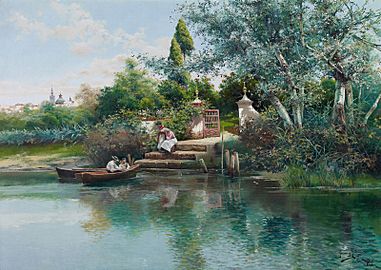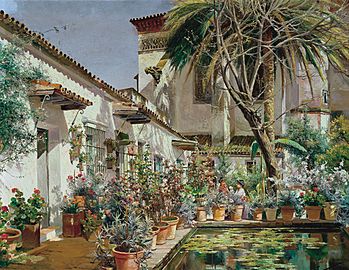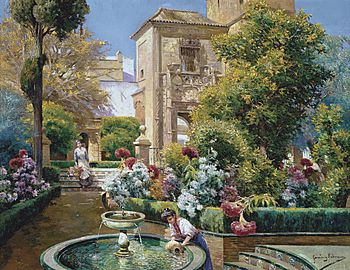Manuel García y Rodríguez facts for kids
Quick facts for kids
Manuel García y Rodríguez
|
|
|---|---|
 |
|
| Born | 1863 Seville, Spain
|
| Died | 6 May 1925 Seville, Spain
|
| Nationality | Spanish |
| Education | José de la Vega Marrugal, Seville; School of Fine Arts, Seville |
| Known for | Painter |
| Movement | Orientalist; costumbrista |
Manuel García y Rodríguez (born 1863 in Seville, died 1925 in Seville) was a Spanish painter. He was known for his beautiful landscapes and scenes of everyday life, often called costumbrista art. He also painted scenes inspired by the Middle East, known as Orientalist art.
About Manuel García y Rodríguez
Manuel García y Rodríguez was born in Seville, Spain, in 1863. He first studied music, but soon realized his true passion was painting. He learned art from José de la Vega Marrugal in Seville. Later, he attended the School of Fine Arts in Seville. There, he was taught by famous artists like Eduardo Cano, Manuel Ussel de Guimbarda, and Emilio Sánchez Perrier.
Manuel was very talented and showed his paintings in many important art shows. He won medals at the National Exhibition of Fine Arts in Spain in 1887, 1890, and 1895. His work was also displayed at big international events. These included the Exposition Universelle (1889) in Paris and the World's Columbian Exposition in Chicago. In 1899, he became a member of the Real Academia de Bellas Artes de San Fernando. This was a big honor for an artist.
In 1904, Manuel visited Tangier, a city in Morocco. This trip inspired him to create paintings in the Orientalist style. This style often shows scenes from North Africa and the Middle East. His paintings can be found in many museums, including the Carmen Thyssen Museum. They are also in private collections. He also drew illustrations for the magazine Blanco y Negro.
Manuel found much of his inspiration from his home city of Seville. He loved painting the Guadalquivir and Guadaira rivers and the areas around them. He was part of the Alcalá de Guadaira school of painting. In his later years, he focused on the gardens, patios, and parks of Seville. During this time, his art started to look more modern and impressionistic.
What He Painted
Manuel García y Rodríguez's work is still well-known today. Many of his landscape paintings were made into black and white illustrations, postcards, and posters. You can see examples of his art in the Museum of Fine Arts in Seville. Many of his paintings are now owned by private collectors.
Here are some of his selected paintings:
- A Morning Stroll by the Canal, 1904
- Patio with Children, 1906
- Alcazar de Sevilla, 1911
- A River Landscape with Seville Beyond, 1912
- A Garden in Seville, 1913
- Seville Garden, 1914
- The Borders of Guadalquivir, 1917
- A Garden in Seville, 1919
- Collecion Bay, Madrid, 1921
- The Rose Garden, 1921
- Seville Patio, 1925
- At the Well
- A Courtyard in Seville
- Easter Procession in Mateos Gago Street, Seville
- Feeding Poultry in a Courtyard
- The Gardens of the Alcazar of Seville
- Mother and Daughter Sewing in a Patio
- Mujer con guitarra, (Woman with Guitar)
- Musician in an Andalusian Palace
- Inside Courtyard, Seville
- Street scene in Granada
Gallery
See also
 In Spanish: Manuel García y Rodríguez para niños
In Spanish: Manuel García y Rodríguez para niños
- List of Orientalist artists
- Orientalism









